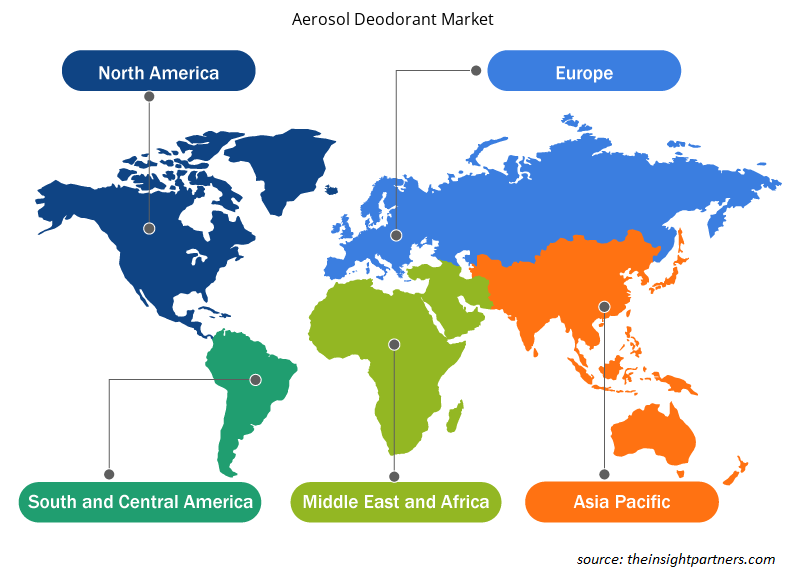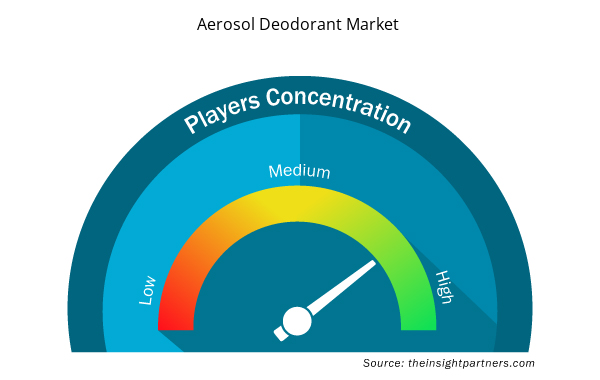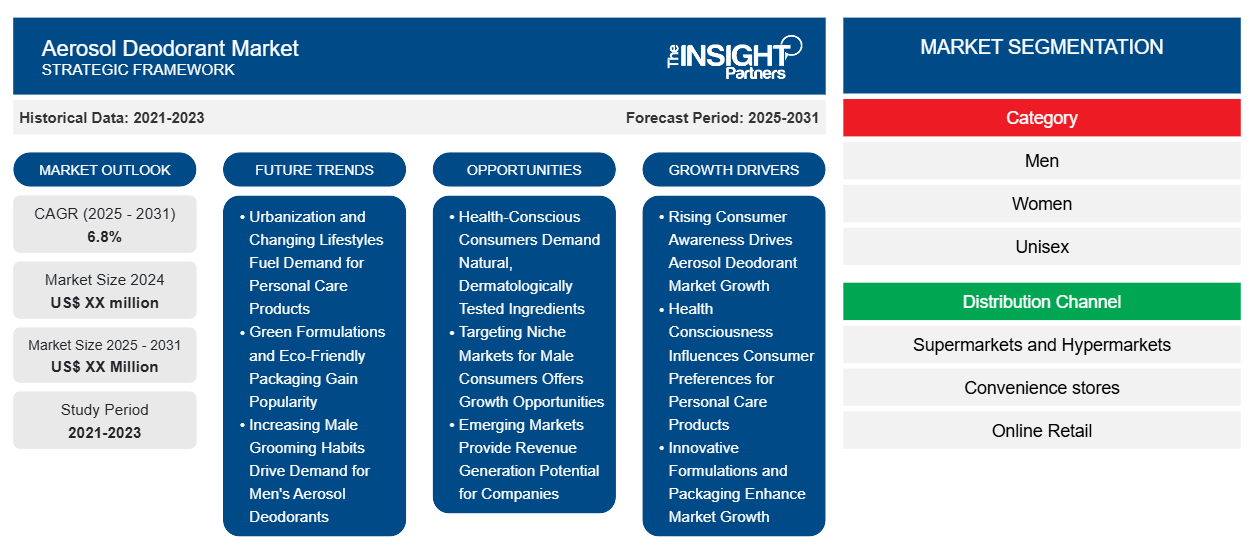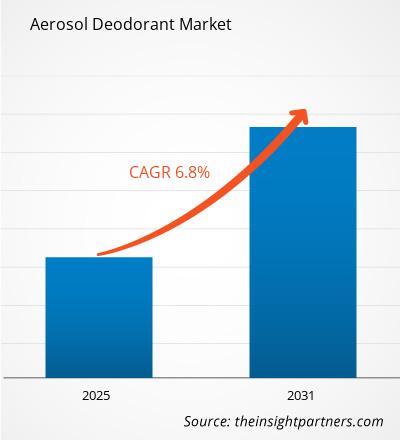Der Markt für Aerosol-Deodorants soll von 2023 bis 2031 eine durchschnittliche jährliche Wachstumsrate (CAGR) von 6,8 % verzeichnen, wobei die Marktgröße von XX Millionen US-Dollar im Jahr 2023 auf XX Millionen US-Dollar im Jahr 2031 anwachsen soll.
Der Marktbericht für Aerosol-Deodorants umfasst eine Segmentanalyse nach Kategorie (Männer, Frauen, Unisex) und Vertriebskanal (Supermärkte und Hypermärkte, Convenience Stores, Online-Einzelhandel, Sonstige). Die globale Analyse wird weiter auf regionaler Ebene und in die wichtigsten Länder unterteilt. Der Bericht bietet den Wert in US-Dollar für die oben genannte Analyse und die Segmente.
Zweck des Berichts
Der Bericht Aerosol Deodorant Market von The Insight Partners zielt darauf ab, die aktuelle Situation und das zukünftige Wachstum sowie die wichtigsten treibenden Faktoren, Herausforderungen und Chancen zu beschreiben. Dies wird verschiedenen Geschäftspartnern Einblicke geben, wie zum Beispiel:
- Technologieanbieter/-hersteller: Um die sich entwickelnde Marktdynamik zu verstehen und die potenziellen Wachstumschancen zu kennen, damit sie fundierte strategische Entscheidungen treffen können.
- Investoren: Durchführung einer umfassenden Trendanalyse hinsichtlich der Marktwachstumsrate, der finanziellen Marktprognosen und der Chancen entlang der Wertschöpfungskette.
- Regulierungsbehörden: Zur Regulierung von Richtlinien und Überwachungsaktivitäten auf dem Markt mit dem Ziel, Missbrauch zu minimieren, das Vertrauen der Anleger zu bewahren und die Integrität und Stabilität des Marktes aufrechtzuerhalten.
Aerosol-Deodorant Marktsegmentierung
Kategorie
- Männer
- Frauen
- Unisex
Vertriebskanal
- Supermärkte und Hypermärkte
- Gemischtwarenläden
- Online-Einzelhandel
- Sonstiges
Passen Sie diesen Bericht Ihren Anforderungen an
Sie erhalten kostenlos individuelle Anpassungen an jedem Bericht, einschließlich Teilen dieses Berichts oder einer Analyse auf Länderebene, eines Excel-Datenpakets sowie tolle Angebote und Rabatte für Start-ups und Universitäten.
- Holen Sie sich die wichtigsten Markttrends aus diesem Bericht.Dieses KOSTENLOSE Beispiel umfasst eine Datenanalyse von Markttrends bis hin zu Schätzungen und Prognosen.
Wachstumstreiber auf dem Aerosol-Deodorant-Markt
- Steigendes Verbraucherbewusstsein treibt das Wachstum des Aerosol-Deodorant-Marktes voran: Steigendes Verbraucherbewusstsein und Körperpflege wirken als Wachstumstreiber für den Aerosol-Deodorant-Markt. Mit zunehmender Hygiene und Körperpflege ist die Nachfrage nach Körperpflegeprodukten wie Deodorant deutlich gestiegen. Praktische Deodorant-Optionen zwingen Hersteller dazu, ihre Produktionslinie zu erweitern und die Produktlinie entsprechend den Verbraucherpräferenzen zu gestalten. Die steigende Nachfrage nach Deodorant hat den Weg für das Wachstum des Aerosol-Deodorant-Marktes geebnet.
- Gesundheitsbewusstsein beeinflusst Verbraucherpräferenzen für Körperpflegeprodukte: Einige der Berichte zeigen die Veränderungen im Kaufverhalten der Verbraucher auf dem Markt für Körperpflegeprodukte. Genauer gesagt treibt ihr Gesundheitsbewusstsein das Wachstum von Produkten wie Blutegelextraktserum, Anti-Cellulite-Cremes, Socken für die Durchblutung, Deodorants, ätherischen Ölen usw. voran. Kaufgewohnheiten wie Online- und Ladeneinkäufe werden stark von diesen Faktoren beeinflusst.
- Innovative Formulierungen und Verpackungen fördern das Marktwachstum: Allmähliche Veränderungen an verschiedenen Fronten wie Aerosolformulierungen und Verpackungen haben dazu beigetragen, den Markt für Aerosol-Deodorants anzukurbeln. Mit einem zunehmenden Fokus auf die Schaffung innovativer Verbrauchererlebnisse in Kombination mit Hautsicherheitsstandards entwickeln Marken neuartige Lösungen, um ihr Marktangebot zu verbessern. Darüber hinaus hat eine verbesserte Produktfunktionalität auch zu Mehrwertoptionen für Endbenutzer geführt. Diese kontinuierlichen Marktverbesserungen haben Produktinnovationen katalysiert und den Markt in Richtung wachstumsstarker Richtungen gelenkt. Darüber hinaus wurden auch Veränderungen der Verbrauchernachfrage festgestellt, die zu neuartigen und benutzerfreundlichen Deodorant-Lösungen tendieren.
- Innovative Formulierungen und Verpackungen fördern das Marktwachstum: Die Diversifizierung des Lebensstils und die schnelle Urbanisierung sind zu den Schlüsselfaktoren geworden, die den Markt für Aerosol-Deodorants prägen. Die zunehmende Migration vom Land in die Stadt und der Ausbruch hektischer Lebensstile erhöhen die Nachfrage nach Körperpflegeprodukten. Lange Arbeitszeiten und Umweltstressoren lösen den tatsächlichen Bedarf aus. Gleichzeitig legen die Menschen Wert auf Komfort, sodass der Markt mehr Möglichkeiten in Bezug auf Komfort und Wirksamkeit bietet. Der Bericht zum Markt für Aerosol-Deodorants stellt die neuen Kräfte vor, die sich aus dem städtischen Lebensstil ergeben.
Zukünftige Trends auf dem Aerosol-Deodorant-Markt
- Urbanisierung und veränderte Lebensstile treiben die Nachfrage nach Körperpflegeprodukten an: Der Markt für Aerosol-Deodorants erlebt Berichten zufolge auch einen Wandel hin zu umweltfreundlichen Rezepturen mit einer stärkeren Einbeziehung umweltfreundlicher Inhaltsstoffe und wiederverwertbarer Verpackungen, da immer mehr Verbraucher solche Produkte aufgrund des gestiegenen Bewusstseins für die Umweltgefahren und der sichereren Ergebnisse bevorzugen. Aufgrund dieses wachsenden Trends erlebt der Markt Produktformulierungsinnovationen, um dieser Nachfrage gerecht zu werden, was letztendlich zur Perfektionierung der Produktportfolios führt, da sie sich anpassen, um solche umweltfreundlichen Alternativen in ihre Produkte aufzunehmen. Neben den offensichtlichen Vorteilen dieser Entwicklung in Bezug auf die Schaffung von Arbeitsplätzen und den breiteren Handel erlebt auch der Markt für Aerosol-Deodorants ein gewisses Maß an Expansion.
- Grüne Rezepturen und umweltfreundliche Verpackungen werden immer beliebter: Da Männer zunehmend männliche Körperpflegegewohnheiten pflegen, ist die Nachfrage nach Deodorants gestiegen. Die größten Auswirkungen haben sich durch veränderte soziale Standards und ein zunehmendes Hygienebewusstsein von Männern ergeben. Daher bringen Hersteller verschiedene Düfte und Rezepturen auf den Markt, die auf den männlichen Sektor zugeschnitten sind. Dieser Trend spiegelt den großen Branchenwechsel wider, der auf die Suche nach einem größeren Marktanteil geht. Beispielsweise ist das Aufkommen von mehr Aerosol-Deodorants für Männer ein Marktwachstum.
- Steigende Pflegegewohnheiten von Männern treiben die Nachfrage nach Aerosol-Deodorants für Männer an: Der Trend zu innovativen Aerosol-Verpackungsdesigns wird voraussichtlich erheblich zum Marktanteil von Aerosol-Deodorants beitragen, da Marken bestrebt sind, benutzerfreundliche und optisch ansprechende Formfaktoren zu finden. Dies wiederum wird das Verbrauchererlebnis verbessern und zur Markendifferenzierung beitragen. Ein Großteil der Innovationen bei Aerosol-Verpackungen für Deodorants wird wahrscheinlich aus Technologien stammen, die zu besseren und nachhaltigeren Verpackungen führen.
Marktchancen für Aerosol-Deodorants
- Gesundheitsbewusste Verbraucher verlangen nach natürlichen, dermatologisch getesteten Inhaltsstoffen: Verbraucher legen immer mehr Wert auf Gesundheit und Wellness und die Nachfrage nach neuen Inhaltsstoffen ohne chemische Verbindungen ist höher als je zuvor. Unternehmen können davon profitieren und Produkte auf der Basis natürlicher Inhaltsstoffe herstellen, die die Gesundheit der Haut verbessern und dermatologisch getestet sind. Die Palette der gesundheitsfördernden Produkte kann Teil der Strategien für den Aerosol-Deodorant-Markt sein, indem die in diesem Bericht zum Aerosol-Deodorant-Markt vorgestellten Erkenntnisse angewendet werden. Aufgrund des Bewusstseins der Verbraucher für die Nachfrage nach sichereren Produkten als je zuvor wird für den Aerosol-Deodorant-Markt in Kürze ein enormes Wachstum prognostiziert.
- Die Ausrichtung auf Nischenmärkte für männliche Verbraucher bietet Wachstumschancen: Angesichts dieses wachsenden Eifers für Körperhygiene bei Männern bietet der Markt für Aerosol-Deodorants eine besondere Gelegenheit, eindeutige Nischenmärkte zu erschließen und Produkte auf männliche Verbraucher auszurichten. Vermarkter können auf Duft und langanhaltende Frische setzen, und manchmal ändern sich die geschützten Formen der Geschlechterkonformität, und die Nachfrage nach Produkten wird wahrscheinlich steigen. Um diese Nachfrage zu befriedigen und ihre Markentreue bei den Verbrauchern zu stärken, werden sich umsichtige Vermarkter von Aerosol-Deodorants ausdrücklich auf eine Unisex- oder speziell männliche Identität festlegen.
- Schwellenmärkte bieten Umsatzpotenzial für Unternehmen: Deshalb sollte sich jedes Unternehmen, das auf dem globalen Markt für Aerosol-Deodorants tätig ist, auf die Schwellenmärkte konzentrieren, da sie in den kommenden Jahren Umsatzmöglichkeiten bieten. Aufgrund der rasanten Urbanisierung sind die verfügbaren Einkommen für Körperpflegeprodukte, eine Kategorie, in der Aerosol-Deodorants wachsen, enorm. Indem Unternehmen diesen Markt nutzen, können sie lokale Märkte erschließen. Von hier aus wird der Markt expandieren. Unternehmen können jetzt den Deodorant-Markt für weitere strategische Planungen nutzen und die Nachfrage danach decken.
Regionale Einblicke in den Aerosol-Deodorant-Markt
Die regionalen Trends und Faktoren, die den Markt für Aerosol-Deodorants im Prognosezeitraum beeinflussen, wurden von den Analysten von Insight Partners ausführlich erläutert. In diesem Abschnitt werden auch die Marktsegmente und die Geografie von Aerosol-Deodorants in Nordamerika, Europa, im asiatisch-pazifischen Raum, im Nahen Osten und Afrika sowie in Süd- und Mittelamerika erörtert.

- Erhalten Sie regionale Daten zum Markt für Aerosol-Deodorants
Umfang des Marktberichts zu Aerosol-Deodorants
| Berichtsattribut | Details |
|---|---|
| Marktgröße im Jahr 2023 | XX Millionen US-Dollar |
| Marktgröße bis 2031 | XX Millionen US-Dollar |
| Globale CAGR (2023 - 2031) | 6,8 % |
| Historische Daten | 2021-2022 |
| Prognosezeitraum | 2024–2031 |
| Abgedeckte Segmente | Nach Kategorie
|
| Abgedeckte Regionen und Länder | Nordamerika
|
| Marktführer und wichtige Unternehmensprofile |
|
Dichte der Marktteilnehmer für Aerosol-Deodorants: Die Auswirkungen auf die Geschäftsdynamik verstehen
Der Markt für Aerosol-Deodorants wächst rasant, angetrieben durch die steigende Nachfrage der Endverbraucher aufgrund von Faktoren wie sich entwickelnden Verbraucherpräferenzen, technologischen Fortschritten und einem größeren Bewusstsein für die Vorteile des Produkts. Mit steigender Nachfrage erweitern Unternehmen ihr Angebot, entwickeln Innovationen, um die Bedürfnisse der Verbraucher zu erfüllen, und nutzen neue Trends, was das Marktwachstum weiter ankurbelt.
Die Marktteilnehmerdichte bezieht sich auf die Verteilung der Firmen oder Unternehmen, die in einem bestimmten Markt oder einer bestimmten Branche tätig sind. Sie gibt an, wie viele Wettbewerber (Marktteilnehmer) in einem bestimmten Marktraum im Verhältnis zu seiner Größe oder seinem gesamten Marktwert präsent sind.
Die wichtigsten auf dem Markt für Aerosol-Deodorants tätigen Unternehmen sind:
- Unilever
- L'Oréal Paris
- Beiersdorf AG
- Colgate-Palmolive-Unternehmen
- Victoria's Secret
Haftungsausschluss : Die oben aufgeführten Unternehmen sind nicht in einer bestimmten Reihenfolge aufgeführt.

- Überblick über die wichtigsten Akteure auf dem Markt für Aerosol-Deodorants
Wichtige Verkaufsargumente
- Umfassende Abdeckung: Der Bericht deckt die Analyse von Produkten, Dienstleistungen, Typen und Endbenutzern des Aerosol-Deodorant-Marktes umfassend ab und bietet einen ganzheitlichen Überblick.
- Expertenanalyse: Der Bericht basiert auf dem umfassenden Verständnis von Branchenexperten und Analysten.
- Aktuelle Informationen: Der Bericht stellt durch die Abdeckung aktueller Informationen und Datentrends Geschäftsrelevanz sicher.
- Anpassungsoptionen: Dieser Bericht kann angepasst werden, um spezifische Kundenanforderungen zu erfüllen und die Geschäftsstrategien optimal anzupassen.
Der Forschungsbericht zum Aerosol-Deodorant-Markt kann daher dabei helfen, die Branchensituation und Wachstumsaussichten zu entschlüsseln und zu verstehen. Obwohl es einige berechtigte Bedenken geben kann, überwiegen die allgemeinen Vorteile dieses Berichts tendenziell die Nachteile.
- Historische Analyse (2 Jahre), Basisjahr, Prognose (7 Jahre) mit CAGR
- PEST- und SWOT-Analyse
- Marktgröße Wert/Volumen – Global, Regional, Land
- Branche und Wettbewerbsumfeld
- Excel-Datensatz



Report Coverage
Revenue forecast, Company Analysis, Industry landscape, Growth factors, and Trends

Segment Covered
This text is related
to segments covered.

Regional Scope
North America, Europe, Asia Pacific, Middle East & Africa, South & Central America

Country Scope
This text is related
to country scope.
Häufig gestellte Fragen
Some of the customization options available based on request are additional 3-5 company profiles and country-specific analysis of 3-5 countries of your choice. Customizations are to be requested/discussed before making final order confirmation, as our team would review the same and check the feasibility.
The report can be delivered in PDF/PPT format; we can also share excel dataset based on the request.
Key companies of this market are: Unilever, L Or al Paris, Beiersdorf AG, Colgate Palmolive Company, Victoria s Secret, Christian Dior SE, Marks and Spencer plc, Godrej Group, CavinKare Group.
The Aerosol Deodorant Market is expected to register a CAGR of 8.8% from 2023-2031.
Key future trends in this market are - Increase in personal care demand, Growth in eco-friendly products, Rise in convenience packaging
The major factors impacting the Aerosol Deodorant Market are: Growing Awareness of Personal Hygiene, Innovative Product Developments, and Rising Urbanization and Lifestyle Changes
Trends and growth analysis reports related to Consumer Goods : READ MORE..
1.Unilever
2.L'Oréal Paris
3.Beiersdorf AG
4.Colgate-Palmolive Company
5.Victoria's Secret
6.Christian Dior SE
7.Marks and Spencer plc
8.Godrej Group
9.CavinKare Group
10.McNROE Consumer Products Private Limited
The Insight Partners performs research in 4 major stages: Data Collection & Secondary Research, Primary Research, Data Analysis and Data Triangulation & Final Review.
- Data Collection and Secondary Research:
As a market research and consulting firm operating from a decade, we have published and advised several client across the globe. First step for any study will start with an assessment of currently available data and insights from existing reports. Further, historical and current market information is collected from Investor Presentations, Annual Reports, SEC Filings, etc., and other information related to company’s performance and market positioning are gathered from Paid Databases (Factiva, Hoovers, and Reuters) and various other publications available in public domain.
Several associations trade associates, technical forums, institutes, societies and organization are accessed to gain technical as well as market related insights through their publications such as research papers, blogs and press releases related to the studies are referred to get cues about the market. Further, white papers, journals, magazines, and other news articles published in last 3 years are scrutinized and analyzed to understand the current market trends.
- Primary Research:
The primarily interview analysis comprise of data obtained from industry participants interview and answers to survey questions gathered by in-house primary team.
For primary research, interviews are conducted with industry experts/CEOs/Marketing Managers/VPs/Subject Matter Experts from both demand and supply side to get a 360-degree view of the market. The primary team conducts several interviews based on the complexity of the markets to understand the various market trends and dynamics which makes research more credible and precise.
A typical research interview fulfils the following functions:
- Provides first-hand information on the market size, market trends, growth trends, competitive landscape, and outlook
- Validates and strengthens in-house secondary research findings
- Develops the analysis team’s expertise and market understanding
Primary research involves email interactions and telephone interviews for each market, category, segment, and sub-segment across geographies. The participants who typically take part in such a process include, but are not limited to:
- Industry participants: VPs, business development managers, market intelligence managers and national sales managers
- Outside experts: Valuation experts, research analysts and key opinion leaders specializing in the electronics and semiconductor industry.
Below is the breakup of our primary respondents by company, designation, and region:

Once we receive the confirmation from primary research sources or primary respondents, we finalize the base year market estimation and forecast the data as per the macroeconomic and microeconomic factors assessed during data collection.
- Data Analysis:
Once data is validated through both secondary as well as primary respondents, we finalize the market estimations by hypothesis formulation and factor analysis at regional and country level.
- Macro-Economic Factor Analysis:
We analyse macroeconomic indicators such the gross domestic product (GDP), increase in the demand for goods and services across industries, technological advancement, regional economic growth, governmental policies, the influence of COVID-19, PEST analysis, and other aspects. This analysis aids in setting benchmarks for various nations/regions and approximating market splits. Additionally, the general trend of the aforementioned components aid in determining the market's development possibilities.
- Country Level Data:
Various factors that are especially aligned to the country are taken into account to determine the market size for a certain area and country, including the presence of vendors, such as headquarters and offices, the country's GDP, demand patterns, and industry growth. To comprehend the market dynamics for the nation, a number of growth variables, inhibitors, application areas, and current market trends are researched. The aforementioned elements aid in determining the country's overall market's growth potential.
- Company Profile:
The “Table of Contents” is formulated by listing and analyzing more than 25 - 30 companies operating in the market ecosystem across geographies. However, we profile only 10 companies as a standard practice in our syndicate reports. These 10 companies comprise leading, emerging, and regional players. Nonetheless, our analysis is not restricted to the 10 listed companies, we also analyze other companies present in the market to develop a holistic view and understand the prevailing trends. The “Company Profiles” section in the report covers key facts, business description, products & services, financial information, SWOT analysis, and key developments. The financial information presented is extracted from the annual reports and official documents of the publicly listed companies. Upon collecting the information for the sections of respective companies, we verify them via various primary sources and then compile the data in respective company profiles. The company level information helps us in deriving the base number as well as in forecasting the market size.
- Developing Base Number:
Aggregation of sales statistics (2020-2022) and macro-economic factor, and other secondary and primary research insights are utilized to arrive at base number and related market shares for 2022. The data gaps are identified in this step and relevant market data is analyzed, collected from paid primary interviews or databases. On finalizing the base year market size, forecasts are developed on the basis of macro-economic, industry and market growth factors and company level analysis.
- Data Triangulation and Final Review:
The market findings and base year market size calculations are validated from supply as well as demand side. Demand side validations are based on macro-economic factor analysis and benchmarks for respective regions and countries. In case of supply side validations, revenues of major companies are estimated (in case not available) based on industry benchmark, approximate number of employees, product portfolio, and primary interviews revenues are gathered. Further revenue from target product/service segment is assessed to avoid overshooting of market statistics. In case of heavy deviations between supply and demand side values, all thes steps are repeated to achieve synchronization.
We follow an iterative model, wherein we share our research findings with Subject Matter Experts (SME’s) and Key Opinion Leaders (KOLs) until consensus view of the market is not formulated – this model negates any drastic deviation in the opinions of experts. Only validated and universally acceptable research findings are quoted in our reports.
We have important check points that we use to validate our research findings – which we call – data triangulation, where we validate the information, we generate from secondary sources with primary interviews and then we re-validate with our internal data bases and Subject matter experts. This comprehensive model enables us to deliver high quality, reliable data in shortest possible time.


 Holen Sie sich ein kostenloses Muster für diesen Bericht
Holen Sie sich ein kostenloses Muster für diesen Bericht